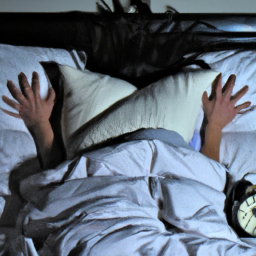As someone who has always been fascinated by the complex workings of the human brain, I often ponder the mysteries of sleep and dreams.
How is it that we can slip so effortlessly into another world while we slumber? And just how long do those dreams actually last?
To answer these questions, we must first understand the different stages of sleep and their relationship to dreaming.
As our bodies rest and recharge during the night, our brains cycle through several distinct phases of sleep, each with its own unique characteristics and functions.
In this article, we will explore the science behind these stages and delve into the fascinating world of dreams – from their duration to common themes and even how they relate to mental health.
So join me as we dive deeper into this mysterious realm of human consciousness!
Key Takeaways
- Most dreams typically last between five and twenty minutes.
- Factors such as age, medication use, and alcohol consumption can affect dream duration.
- Poor sleep quality can result in shorter dream periods or no dreams at all.
- The most vivid and memorable dreams occur during REM sleep.
Explanation of Sleep Stages
Let’s dive into the fascinating world of sleep stages, where dreams can last anywhere from a few seconds to up to 20 minutes. Our brains cycle through two main types of sleep: rapid eye movement (REM) and non-rapid eye movement (NREM).
NREM is further divided into three stages. During NREM stage one, we’re in light sleep and may experience sudden muscle contractions or hypnic jerks. In stage two, our brain waves slow down, and body temperature drops. Finally, during stage three, we enter deep sleep where it’s difficult to wake us up.
During REM sleep, our eyes move rapidly back and forth behind closed eyelids as if watching a movie. The rest of our body becomes paralyzed to prevent us from acting out our dreams. Interestingly enough, most dreaming occurs during this stage, which usually happens about 90 minutes after falling asleep and recurs every 90-120 minutes throughout the night.
As we go through multiple cycles of NREM and REM sleep, the duration of each cycle changes with more time spent in REM towards morning. Sleep cycle patterns vary among individuals but generally follow a predictable pattern that alternates between NREM and REM phases throughout the night.
Understanding these stages helps us better comprehend how long dreams can last since they occur primarily during REM sleep, when the brain is highly active despite being physically still. With that said, let’s explore how dreams fit into the bigger picture of our sleeping habits without missing a beat!
The Relationship Between Dreams and Sleep
As we drift off into slumber, our minds transport us to a realm of endless possibilities and surreal scenarios. This is where dreams take place a phenomenon that has puzzled scientists for decades.
The exact relationship between dreaming and sleep is still not well understood, but researchers have been able to uncover some insights. One important aspect of dreaming is its role in memory consolidation. Dreams allow the brain to process and organize information obtained during waking hours, which can improve overall cognitive function. Additionally, studies have shown that dreams may help with problem-solving by allowing the mind to explore different solutions without the limitations of reality.
The most vivid and memorable dreams occur during Rapid Eye Movement (REM) sleep. This stage of sleep is characterized by rapid eye movements, shallow breathing, and increased brain activity. It’s believed that REM sleep plays a crucial role in emotional regulation and learning processes. As such, it’s no surprise that many theories suggest a strong link between dreams and REM sleep.
Dreams are an integral part of the human experience that continue to fascinate scientists and laypeople alike. By exploring their relationship with memory consolidation and the role of REM sleep in dreaming, researchers have made significant progress towards understanding this enigmatic phenomenon.
But now let’s move on to the next question how long do these imaginative excursions actually last?
How Long Do Dreams Actually Last?
The duration of our imaginative excursions during sleep can offer insights into the complexity and depth of our subconscious minds. Dreams have fascinated scientists for centuries, yet we still don’t fully understand their purpose or how they work.
One aspect that researchers have been able to study is dream duration. The science behind dream duration reveals that dreams typically last between five and twenty minutes, although they can be as short as a few seconds or as long as an hour. The length of a dream depends on which stage of sleep it occurs in, with most dreaming happening during Rapid Eye Movement (REM) sleep.
During REM sleep, the brain is highly active and processes information from the day while also creating vivid images and storylines. The impact of the REM cycle on dreams means that some people may experience longer dreams than others depending on their sleeping patterns.
Factors such as age, medication use, and alcohol consumption can also affect dream duration. Understanding these factors can provide us with greater insight into how our brains function during sleep and what influences our subconscious thoughts and experiences.
Factors That Affect Dream Duration
Factors like age, medication, and alcohol intake can impact how long our nighttime fantasies continue as they’re mainly influenced by the REM cycle.
Certain medications can affect the duration of our dreams by suppressing or enhancing the REM stage. For example, antidepressants are known to decrease the amount of time spent in REM sleep, which could lead to shorter dream periods.
Sleep quality also plays a crucial role in determining how long we dream for. Poor sleep quality means that we may not spend enough time in the REM stage of sleep, which is when most dreaming occurs. This could result in shorter dream periods or even no dreams at all. On the other hand, getting enough high-quality sleep can lead to longer and more vivid dreams.
It’s important to note that factors affecting dream duration are highly subjective and vary from person to person. What works for one individual may not work for another due to differences in physiology and lifestyle choices.
Understanding these factors can help improve our overall sleep quality and ultimately enhance our dreaming experience. Moving forward, let’s explore common themes found in dreams and how they relate to our daily lives.
Common Themes in Dreams
As a dream researcher, I find it fascinating to explore the common themes that people experience in their dreams.
Falling, flying, and being chased are some of the most prevalent motifs that appear across cultures and age groups. These themes often reflect our subconscious fears and desires, such as loss of control or seeking freedom.
By studying these recurring patterns in dreams, we can gain insight into the human psyche and how our minds process emotions during sleep.
Falling
Have you ever had that feeling of falling in a dream and it seems to last forever? Falling dreams are one of the most common types of dreams, and they often leave us feeling uneasy or scared. These dreams can occur during any stage of sleep, but they typically happen during the rapid eye movement (REM) phase.
Falling dreams can be interpreted in many ways through dream symbolism; some believe that they represent a loss of control or powerlessness in our waking life. Despite how real falling dreams may seem, they actually don’t last very long. Studies have shown that most dreams, including falling dreams, only last for a few seconds to a few minutes.
However, because our brain processes time differently during dreaming versus waking life, it can feel like we’re falling for much longer than we actually are.
Now let’s transition into talking about flying in dreams without missing a beat!
Flying
Flying in dreams is a thrilling experience that can make us feel free and empowered. Lucid dreaming techniques, such as reality checks and keeping a dream journal, can increase the likelihood of having flying experiences in dreams.
During these experiences, our brains create vivid sensations of wind rushing past our faces and the sensation of weightlessness as we soar through the air. Some people report feeling more confident and capable after having a flying dream, which may be due to the sense of control they feel while in flight.
However, it’s important to note that not everyone experiences flying dreams or lucid dreaming techniques in the same way. As we explore different dream scenarios like being chased, we may find that certain techniques work better for some individuals than others.
Being Chased
Flying dreams may be exhilarating, but being chased in a dream can evoke feelings of anxiety and fear. When I’m being pursued in my dreams, it feels like the predator is closing in on me with every step.
My heart races, and my body tenses up as I try to run away or hide. But why do we have these intense dreams of being chased?
Psychological effects play a significant role in our dream experiences. Being chased can represent a feeling of being overwhelmed or pursued by something that we can’t escape from in our waking life. Our subconscious mind uses these scenarios to process unresolved emotions and fears that we may not even be aware of consciously.
Additionally, cultural interpretations also impact the content of our dreams. For example, some cultures believe that dreaming about being chased signifies impending danger or an upcoming obstacle that needs to be overcome.
Three common themes that appear when dreaming about being chased are: feeling trapped or cornered, being unable to move quickly enough, and having no control over the situation.
Understanding these themes and interpreting them can help us identify hidden anxieties and concerns that need attention in our waking life.
In the next section, we’ll explore how lucid dreaming can give us more control over our dream experiences.
Lucid Dreaming
If you’re looking for a way to take control of your dreams, lucid dreaming is an exciting and rewarding experience. Lucid dreaming is the ability to be aware that you are in a dream state, allowing you to manipulate the dream environment and control your actions within the dream. There are various techniques that can help induce lucid dreaming, such as reality testing and keeping a dream journal.
Reality testing involves checking whether you are awake or asleep by asking yourself questions throughout the day, such as “am I dreaming?”This habit will eventually carry over into your dreams, where you may become aware that you are in a dream state. Keeping a dream journal can also aid in achieving lucid dreams by helping to identify common themes or patterns in your dreams.
Once you have achieved lucidity in a dream, there are various methods for controlling the outcome of the dream. One popular technique is known as ‘dream spinning’, which involves spinning around in circles within the dream world to change its scenery or setting. Another method is known as ‘lucid summoning’, where one can bring objects or characters into existence simply by focusing on them.
Lucid dreaming can be an incredible tool for personal growth and self-discovery. However, it’s important to note that like any skill, it takes practice and patience to master. In order to fully harness its potential benefits, one must be willing to commit time and effort towards developing their ability to control their dreams.
As much as we desire pleasurable experiences during our sleep hours through lucid dreaming, sometimes nightmares could overshadow our efforts. Nightmares could come from various sources; some people suffer from post-traumatic stress disorder (PTSD) nightmares while others have recurrent nightmare disorder (RND). It’s essential for individuals who frequently experience bad dreams affecting mental health seek professional assistance from therapists specialized in treating sleep disorders.
Nightmares
You might find yourself jolting awake in the middle of the night, sweating profusely and your heart racing after experiencing a terrifying nightmare. Nightmares are vivid dreams that can cause intense fear, anxiety, and distress. They usually occur during REM sleep and can last anywhere from a few seconds to several minutes.
Coping mechanisms for nightmares include practicing relaxation techniques before bed such as deep breathing or meditation. It’s also helpful to establish a regular sleep schedule and avoid consuming alcohol or caffeine before bedtime. In some cases, therapy may be necessary if nightmares are frequent or severe enough to affect mental health.
The effects of nightmares on mental health can vary depending on the individual’s coping mechanisms and support system. For some people, frequent nightmares can lead to symptoms of anxiety or depression. However, with proper treatment and coping strategies in place, individuals can learn to manage their nighttime fears and reduce the negative impact on their overall well-being.
Interpreting dreams is often seen as a way to gain insight into one’s subconscious thoughts and emotions.
Dream Interpretation
When interpreting your dreams, try to tap into the hidden meanings and messages behind the symbolism presented in your subconscious state. Dreams are full of symbolic representation that can be interpreted in various ways. Dream analysis is a process of understanding those symbols and their implications on our conscious life. Here are five factors to consider when interpreting your dreams:
- Context: Consider what was happening before the dream started and what happened after it ended.
- Emotions: Pay attention to how you felt during the dream and how you feel about it now.
- Symbols: Identify any recurring themes or objects that appeared in the dream.
- Personal experiences: Think about any personal experiences related to the symbols present in your dream.
- Culture & society: Consider how cultural and societal norms may have influenced your dream.
By analyzing these factors, we can uncover hidden meanings within our dreams that may be relevant to our waking life. Dream interpretation can provide insight into our innermost thoughts, fears, desires, and hopes. Understanding ourselves through our dreams can lead to greater self-awareness and personal growth.
Understanding the relationship between dreams and mental health is crucial for wellbeing. Dreams can be a reflection of our mental state, whether positive or negative. They may reveal underlying stressors or emotional conflicts that need attention. By paying attention to our dreams, we can identify potential issues early on and take steps towards resolving them before they impact our mental health negatively.
The Relationship Between Dreams and Mental Health
Understanding the relationship between dreams and mental health is crucial for maintaining overall wellbeing, as they can provide insight into our subconscious state and reveal underlying stressors or emotional conflicts. Dreams are a natural part of the human experience, but their significance goes beyond just being a series of random events that occur during sleep. In fact, research has shown that dreams have a significant impact on our emotional and cognitive processing.
One function of dreams is to help regulate our emotions. Dreams often reflect our emotional states and can serve as a way to process difficult emotions or experiences. For example, if someone is struggling with anxiety, they may have recurring nightmares about the situations that trigger their anxiety. While these nightmares may be unpleasant, they provide an opportunity for the individual to confront and process their fears in a safe environment.
Additionally, dreams play an important role in cognitive processing. During sleep, our brains continue to process information from the day before, including memories and new learning. Dreams can help consolidate this information by integrating it into existing knowledge structures in the brain. This means that dreaming can potentially enhance memory retention and improve problem-solving abilities.
Overall, understanding the connection between dreams and mental health underscores how essential it is to prioritize quality sleep habits as part of self-care practices. By paying attention to dream content and patterns over time, individuals may be able to identify areas of stress or conflict in their lives that require further attention or support from mental health professionals.
Frequently Asked Questions
Can dreaming ever be harmful to our mental health?
Dream interpretation and nightmare prevention are important for mental health. While dreams themselves can’t harm us, the emotions they evoke may impact our mood. It’s crucial to actively work on interpreting and preventing negative dreams to promote positive mental well-being.
Why do some people remember their dreams more vividly than others?
As a researcher, I’ve found that memory processing and sleep quality play a significant role in dream recall. Those with better memory and more restful sleep cycles tend to remember their dreams more vividly.
Is it possible for a dream to last for hours or even days?
Dreams can last from a few seconds to 30 minutes. During REM sleep, the stage where most dreaming occurs, dreams can become more vivid and complex. However, it is not possible for dreams to last for hours or days.
Do animals dream like humans do?
Animal dream research suggests that many species dream, including mammals, birds and reptiles. However, it is difficult to interpret dreams in animals as we cannot ask them about their experiences or thoughts during sleep.
Can lucid dreaming be used as a form of therapy?
Lucid dreaming can be used as a form of therapy due to its benefits in reducing anxiety, PTSD, and nightmares. Techniques such as reality checks and keeping a dream journal can increase the likelihood of achieving lucidity.
Conclusion
In conclusion, the duration of dreams is dependent on various factors such as sleep stage and individual differences. Dreams can last anywhere from a few seconds to 30 minutes, and they occur most frequently during the rapid eye movement stage of sleep.
However, it’s important to note that while dreams may seem like they last for hours, they mostly occur during short time periods. While some people may experience lucid dreaming or nightmares, others may have recurring themes in their dreams.
Dream interpretation can be useful in understanding one’s subconscious thoughts and emotions. Furthermore, research has shown that there is a relationship between dreaming and mental health, with an increase in dream activity associated with certain psychiatric disorders.
Overall, although we spend a third of our lives sleeping and dreaming, much remains unknown about this fascinating phenomenon. While science continues to unravel the mysteries of the human mind during sleep, our dreams continue to provide us with insight into ourselves and our deepest desires.









